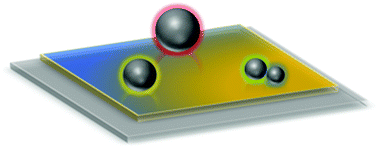当前位置:
X-MOL 学术
›
Nanoscale Horiz.
›
论文详情
Our official English website, www.x-mol.net, welcomes your feedback! (Note: you will need to create a separate account there.)
Active tuning of the Fano resonance from a Si nanosphere dimer by the substrate effect†
Nanoscale Horizons ( IF 9.7 ) Pub Date : 2018-08-31 00:00:00 , DOI: 10.1039/c8nh00198g Yingcong Huang 1, 2, 3, 4, 5 , Jiahao Yan 1, 2, 3, 4, 5 , Churong Ma 1, 2, 3, 4, 5 , Guowei Yang 1, 2, 3, 4, 5
Nanoscale Horizons ( IF 9.7 ) Pub Date : 2018-08-31 00:00:00 , DOI: 10.1039/c8nh00198g Yingcong Huang 1, 2, 3, 4, 5 , Jiahao Yan 1, 2, 3, 4, 5 , Churong Ma 1, 2, 3, 4, 5 , Guowei Yang 1, 2, 3, 4, 5
Affiliation

|
All-dielectric materials have aroused great interest for their unique light scattering and lower losses compared with plasmonics. Generally, optical properties made by all-dielectric materials can be passively controlled by varying the geometry, size and refractive index at the design stage. Therefore, the realization of active tuning in the field of nanophotonics is important to improve the practicality and achieve light-on-chip technology in the future. Herein, we combine the high refractive index of Si and the phase transition of VO2 to form an active tuning hybrid nanostructure with higher quality factor by depositing Si nanospheres on the VO2 layer with an Al2O3 substrate. As the temperature goes up, the refractive index of the VO2 layer switches from high to low. The scattering intensity of the magnetic dipole resonance of Si nanospheres decreases differently depending on their size, while the intensity of the electric dipole resonance remains almost unchanged. Meanwhile, Fano resonances are observed in the Si nanosphere dimers with a continuous variable Fano lineshape when adjusting the temperature. Mie theory and substrate-induced resonant magneto-electric effects are used to analyze and explain these phenomena. Tuning of the Fano resonance is attributed to the substrate effect from the interaction between Si nanospheres and phase transition of the VO2 layer with temperature. These light scattering properties of such a hybrid nanostructure make it promising for temperature sensing or as a light source at the nanometer scale.
中文翻译:

通过底物效应主动调整Si纳米球二聚体的Fano共振†
与等离子体技术相比,全电介质材料因其独特的光散射和较低的损耗而引起了人们的极大兴趣。通常,可以在设计阶段通过改变几何形状,尺寸和折射率来被动控制由全介电材料制成的光学特性。因此,实现纳米光子学领域中的主动调谐对于提高实用性和实现未来的片上照明技术具有重要意义。本文中,我们通过将Si纳米球与Al 2 O 3沉积在VO 2层上,结合了Si的高折射率和VO 2的相变,形成了具有更高品质因数的有源调谐杂化纳米结构。基质。随着温度升高,VO 2层的折射率从高切换到低。Si纳米球的磁偶极子共振的散射强度根据其大小而不同地降低,而电偶极子共振的强度几乎保持不变。同时,当调节温度时,在具有连续可变的Fano线形的Si纳米球二聚体中观察到Fano共振。米氏理论和衬底感应的共振磁电效应被用来分析和解释这些现象。Fano共振的调谐归因于Si纳米球之间的相互作用和VO 2的相变带来的基片效应层的温度。这种杂化纳米结构的这些光散射特性使其有望用于温度感测或作为纳米级的光源。
更新日期:2018-08-31
中文翻译:

通过底物效应主动调整Si纳米球二聚体的Fano共振†
与等离子体技术相比,全电介质材料因其独特的光散射和较低的损耗而引起了人们的极大兴趣。通常,可以在设计阶段通过改变几何形状,尺寸和折射率来被动控制由全介电材料制成的光学特性。因此,实现纳米光子学领域中的主动调谐对于提高实用性和实现未来的片上照明技术具有重要意义。本文中,我们通过将Si纳米球与Al 2 O 3沉积在VO 2层上,结合了Si的高折射率和VO 2的相变,形成了具有更高品质因数的有源调谐杂化纳米结构。基质。随着温度升高,VO 2层的折射率从高切换到低。Si纳米球的磁偶极子共振的散射强度根据其大小而不同地降低,而电偶极子共振的强度几乎保持不变。同时,当调节温度时,在具有连续可变的Fano线形的Si纳米球二聚体中观察到Fano共振。米氏理论和衬底感应的共振磁电效应被用来分析和解释这些现象。Fano共振的调谐归因于Si纳米球之间的相互作用和VO 2的相变带来的基片效应层的温度。这种杂化纳米结构的这些光散射特性使其有望用于温度感测或作为纳米级的光源。



























 京公网安备 11010802027423号
京公网安备 11010802027423号